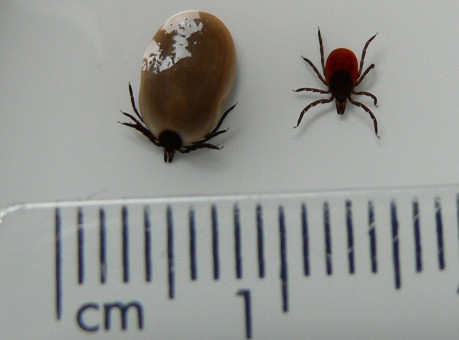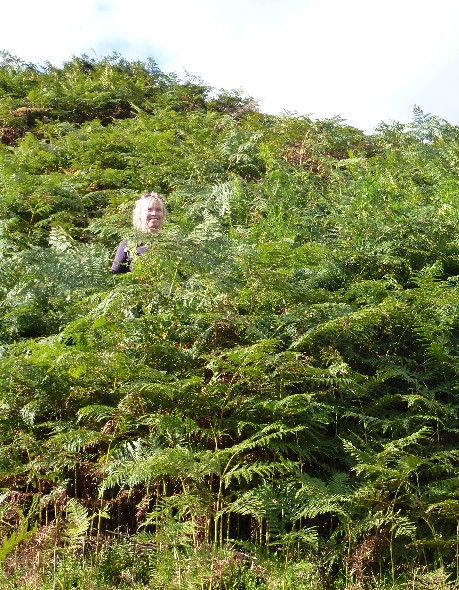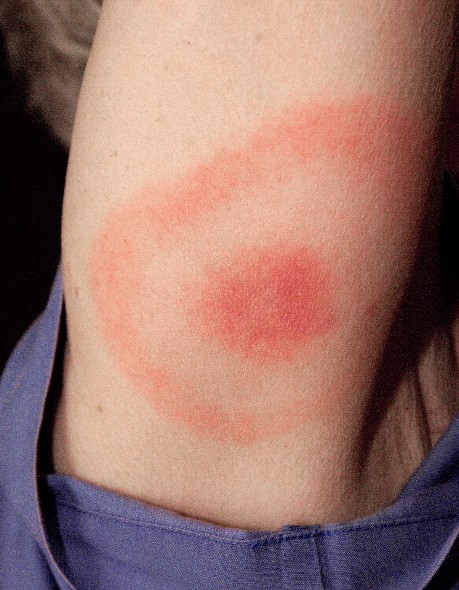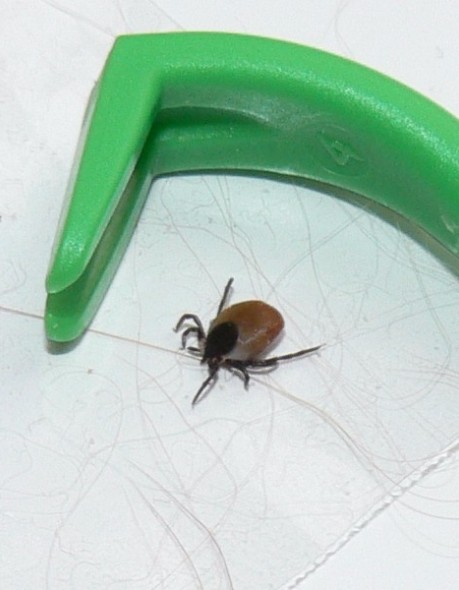Although ticks were once regarded as nothing more than a bloodthirsty nuisance, increasing awareness of Lyme Disease and its potentially long-lasting effects means people are more concerned about ticks, how to avoid them, and how best to deal with them.
The tick is an invertebrate related to spiders. There are over twenty species in Britain related to various different mammal or bird hosts. They carry a number of diseases, the most well known of which is Lyme disease.
They can be found all across Scotland and particularly in the wetter west, in woodlands, moorlands and long grass.
Scientists recorded more than 800,000 ticks in just a short stretch of thick vegetation at the side of a path. They are active all through the year, but particularly in summer.

Two ticks of same type: the one on on the left is engorged after feeding, while the one on the right has not fed
What's the problem?
- The tick has three life stages: larva, nymph and adult, taking between one and three years to complete a life-cycle. Each stage requires a single blood meal to grow. It is when they are feeding that ticks can pass on infections and bacteria.
- Both larval and nymph stages of the ‘sheep tick’, the most common species found in Scotland, are the ones most commonly encountered by walkers. They climb to the top of foliage and attach to passing animals, generally small mammals, but they will also feed on humans if they get the chance. Climbers on sea cliffs can be at risk of encountering tick species, like the 'seabird tick' too.
- The tick's bite is painless and some ticks can be as small as a poppy seed or spec of dirt, so it can be easy to overlook them. A tick will generally remain attached until it is gorged with blood, increasing greatly in size, before dropping off. This can take between a few days and 2 weeks.
Top tips for avoiding ticks
When you are out and about in the hills try to:
- Avoid walking through long grass and areas of thick foliage - consider keeping to paths and tracks in heavily infested areas.
- Leave no exposed skin on your legs, feet, ankles or arms - wear long sleeves, tuck trousers into your socks or wear gaiters, choose fabric which is thickly woven.
- Spray insect repellent on clothing and socks.
- Wear light-coloured clothing so you can see the dark ticks and remove them - inspect clothing often to remove the ticks.
- Check yourself, your children and your pets for ticks when you get home, especially your hairline, navel, groin, arm pits, between toes, behind the ears and knees.

Lush growth on the hill - ideal tick terrain
Firstly, don’t panic if you find an embedded tick – it's most likely that it's not infected, and if you remove it within 24 hours it is unlikely to have passed on the bacteria.
- The most reliable method of removing a tick without leaving any remnants in your skin is to purchase a tick hook.
- Tick hooks come in different sizes for different sizes of tick and only cost a few pounds - they also come with instructions for safe removal. Essential kit for outdoorsy people (use your membership card to get a discount at these outdoor shops).
- Don’t use a lighted cigarette or match or essential oils to encourage the tick to fall off and don't squeeze the tick (especially one that is engorged with blood) as this will inject the fluid in the tick back into your body.
Lyme disease is notoriously difficult to diagnose as it can demonstrate different symptoms in different people and some of the symptoms are similar to other infections and illnesses.
- It takes up to 24 hours before the bacteria are transmitted from the tick to its host and symptoms of infection may appear at any time within two weeks after the bite.
- A common sign is a distinctive bulls-eye rash that may appear (though not always) around the area of the bite. As infection spreads several rashes can appear at different sites on the body.
- Other symptoms include fatigue, fever, headaches, stiff neck and body aches - similar to the flu. These symptoms may be persistent or may occur intermittently.
>>> If you experience any of these symptoms, see your GP immediately and mention your concerns about Lyme disease.

The 'bullseye' rash that can signify Lyme Disease
Early treatment with antibiotics is required in order to be effective in lessening the short-term symptoms and the long-term complications. Full recovery is possible, but treatment in the later stages of infection is more difficult and relapses are common.
After several months of being infected, about ˝ of those treated with antibiotics develop recurrent attacks of painful and swollen joints (arthritis) that last from a few days to a few months. The arthritis can shift from joint to joint, the knee being most commonly affected. About 10-20% of infected patients will develop chronic arthritis.
Research indicates that the variant found in Scotland is different to that found elsewhere in the UK. The Scottish variant seems to cause more neurological problems with symptoms ranging from stiff neck, severe headache, meningitis, temporary paralysis of the facial muscles (Bell’s Palsy), numbness and poor motor coordination.
You can also find out more about ticks and Lyme disease at the following links:



